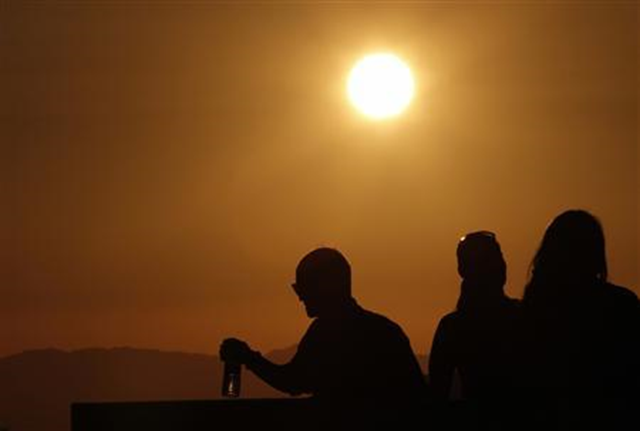Western United States swelters amid deadly heat – 72 percent of West now in drought
By Tim Gaynor, with additional reporting by Jane Sutton in Miami, Brad Poole in Tucson, Timothy Pratt in Las Vegas, and Marty Graham in San Diego; Editing by Doina Chiacu and Stacey Joyce
30 June 2013 PHOENIX (Reuters) – A dangerous, record-breaking heat wave in the western United States contributed to the death of a Nevada resident and sent scores of people to hospitals with heat-related illnesses. The scorching heat, caused by a dome of hot air trapped by a high pressure ridge, pushed the mercury above 100 F (38 C) in parts of California, Arizona, Idaho, Colorado, Nevada, Utah, and Texas. Paramedics in Las Vegas, where searing temperatures reached an all-time high of 118 F (48 C) on Saturday, found an elderly man dead in his apartment, which had no air-conditioning. The unidentified man had prior medical issues and “either the heat got to him or the medical condition was aggravated by the heat,” Las Vegas Fire & Rescue spokesman Tim Szymanski said. Scores of other people were treated for heat-related symptoms, including a man who pulled off a Nevada highway and called 911 to say he felt ill after driving for several hours without air-conditioning. He was hospitalized in serious condition with heat stroke, Szymanski said. Cities and towns across the sun-scorched western United States opened air-conditioned “cooling centers” in community centers, homeless shelters and libraries, and warned residents to avoid prolonged exposure to the high temperatures. “It’s like when you open up the door to your oven and you get that blast of hot air. That’s kind of what it feels like outside,” said Charlotte Dewey, a weather service meteorologist in Phoenix, Arizona, where temperatures nudged 114 F (46 C) on Sunday. “It’s pretty dangerous, even for people who are very acclimated to the weather, to be outside and doing physical activity … we advise everybody to avoid being outdoors,” Dewey added. In Los Angeles County, many people have been hospitalized or treated for dehydration, exhaustion and heat stroke, a fire department spokesman said. There were fears that migrants attempting to cross into the United States from Mexico would die in the desert. More border agents were added on the American side, said Brent Cagen, a spokesman for the Tucson sector of the U.S. Border Patrol. At least three people who attempted to illegally cross the border into Arizona were found dead this week, likely succumbing to the heat, Cagen said. Firefighters worry about dry conditions, which have ignited several major brush fires across the region recently, and about more blazes ignited by wayward fireworks launched from backyards to commemorate the Fourth of July holiday.
Western United States swelters amid deadly heat 
30 June 2013 (AP) – A record-breaking heat wave intensified drought conditions in much of the West during the past week, with 72 percent of the land area in the 10 Western states now in drought conditions, according to the latest update to the U.S. Drought Monitor. The worst impacts of the drought are concentrated in the Southwest: New Mexico, Texas, Southern Colorado and the western parts of Kansas, Oklahoma and Nebraska all contain land that is under extreme or exceptional drought. The hot weather — Denver had its earliest 100-degree day on June 12 — served to exacerbate existing drought conditions and helped fuel deadly wildfires in Arizona, California, Colorado, Nevada, New Mexico, and Oregon. In California, 2013 has been the driest year on record to date, and the lack of rainfall is making the state more vulnerable to wildfires. “The overall pattern of hot and dry conditions, combined with year-to-date below normal precipitation, led to continued deterioration of pasture and rangeland conditions across Arizona, California, Nevada and New Mexico,” said David Simeral of the Western Regional Climate Center, in a statement accompanying the Drought Monitor. According to the U.S Department of Agriculture (USDA), 100 percent of the range and pasture land in New Mexico is in poor or very poor condition. The ongoing problem of drought was a major focus of the spring State of the Climate report, which was released by the National Oceanic and Atmospheric Administration this week. This year, the period from March to May has been the second-driest on record in New Mexico, where water supply concerns are escalating. By contrast, Iowa, Illinois, and Wisconsin are all having their wettest year to date. Heavy rainfall in the Midwest and the Mississippi River Valley caused the Mississippi River at St. Louis to crest at its sixth-highest level. As of this week, 44.13 percent of the continental U.S. is under moderate drought or worse, and all of that land is now in states west of the Mississippi River. [more]
